Technical Desktops - Accessories
 | 300 Series Selection: |
| 1) 98633A Multiprogrammer Interface (1985) | |
| 2) 36941A X.25 Connector (1985) | |
| 3) 98543A Color Video Interface (1985) | |
| 4) 98643A LAN-300 Thin MAU (1985) | |
| 5) 98542A Mono Monitor Interface (1985) | |
| 6) 98546 Mono Video Interface (1985) | |
| 7) 98545A Video Interface (1985) | |
| 8) 98641A RJE Interface (1985) | |
| 9) 98786A Monochrome Monitor (1986) | |
| 10) 98544B Mono Video Interface (1986) | |
| 11) 98568A I/O Expander (1986) | |
| 12) 98785A Color Monitor (1986) | |
| 13) 98547A Video Interface (1986) | |
| 14) 98646A VMEbus Interface (1986) | |
| 15) 98286A DOS Coprocessor (1986) | |
| 16) 98752A 19 Inch Monitor (1987) | |
| 17) 98789A Color Monitor (1987) | |
| 18) 98550A Monitor Adaptor (1987) | |
| 19) 98258A 4 MB Memory Controller (1987) | |
| 20) 98258B 4 MB Board (1987) | |
| 21) 98638A MUX Board (1987) | |
| 22) 98751A 19-inch Monitor (1987) | |
| 23) 98556A Graphics Accelerator (1987) | |
| 24) 98265A SCSI Board (1987) | |
| 25) 98267A 4 MB RAM for 360 (1988) | |
| 26) 98267C 12 MB RAM for 360 (1988) | |
| 27) 28641A ThinMAU Coax Adapter (1988) | |
| 28) 28664A Twisted Pair MAU (1988) | |
| 29) 98549A Video Interface (1988) | |
| 30) 98548A Mono Video Interface (1988) | |
| 31) HP Visual User Environment (1989) | |
| 32) 98658A SCSI Interface (1989) | |
| 33) 98268A 4 MB for 340 (1989) | |
| 34) 98754A Color Monitor (1990) | |
| 35) 98705 Graphics Processor (1990) | |
| 36) 98229A 4 MB For 375/380 (1991) | |
| 37) 98229E 32 MB for 375/380 (1991) | |
| 38) 98229B 8 MB for 375/380 (1991) | |
The 300 Series was a fully-modular family of technical computers. All components came in separate boxes with separate power supplies. These components included: system units, disc drives, tape drives, monitors, input and output devices. The industrial design of the the 300 series was very functional and very elegant, and has not been appreciably improved upon to this day. Although functional and aesthetic winners, these products do not make ideal museum displays because they all look the same (many of the system units are not even differentiated by a different part or model identifier on the front of the machine). The 300 Series was based on the Motorola 680X0 family of CPUs beginning with the model 310 sporting a 68010. The primary operating environment of 300 Series computers was HP-UX. Many languages were offered including BASIC, Pascal, HPL, C and FORTRAN. Bundled versions of the Series 300 were available based on the graphics configuration of particular machines. The bundled options were: entry level monochrome (M), high-performance monochrome (MH), mid-range color (C+), high-performance color (CH), Accelerated color (CHX), entry-level 3D (SRX) and high-performance 3D (TurboSRX). Click here to see Thomas Schanz' video on the boot sequence for a Series 300 computer running HP-UX. If you are looking for manuals on the HP-UX operating system, utilities and applications from the 1990s, the best source is one of HP's Instant Information CDs. The manuals can be printed directly from the disc. The list of manuals on the 1997 disc is here. The list of manuals from the 1999 disc is here. Contact us if you need one of these discs. | |
| Back |
^ TOP©2004 - 2024 BGImages Australia - All Rights Reserved.
The HP Computer Museum and BGImages Australia are not affiliated with HP Inc. or with Hewlett Packard Enterprise. Hewlett Packard and the HP logo are trademarks of HP Inc and Hewlett Packard Enterprise. This website is intended solely for research and education purposes.
